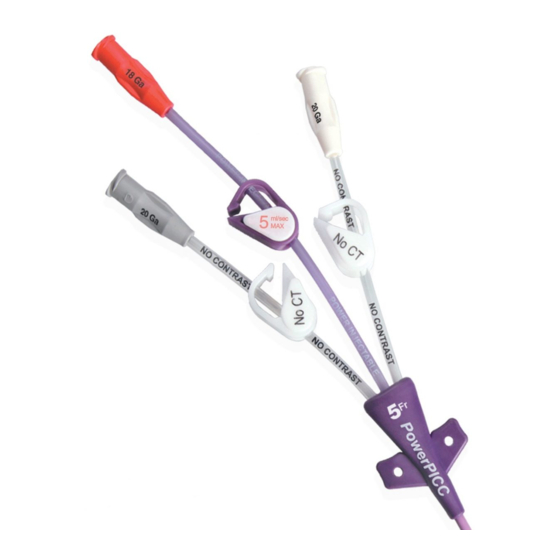Advertisement
Revised date: January 2018
Bard, PowerPICC, Provena, Sherlock and StatLock are
trademarks and/or registered trademarks of C. R. Bard, Inc.
All other trademarks are the property of their respective
owners.
© 2018 C. R. Bard, Inc. All rights reserved.
Manufacturer:
Bard Access Systems, Inc.
605 North 5600 West
Salt Lake City, UT 84116 USA
801-522-5000
Clinical Information Hotline: 1-800-443-3385
Ordering Information:
1-800-545-0890
www.powerpicc.com
www.bardaccess.com
www.discoversherlock.com
0745270 1801R
Nursing
Polyurethane
Catheter
with Microintroducer
Advertisement
Table of Contents

Summary of Contents for Bard PowerPICC Provena
- Page 1 Microintroducer Revised date: January 2018 Bard, PowerPICC, Provena, Sherlock and StatLock are trademarks and/or registered trademarks of C. R. Bard, Inc. All other trademarks are the property of their respective owners. © 2018 C. R. Bard, Inc. All rights reserved.
-
Page 2: Product Description
Product Description A family of peripherally inserted central catheters made from specially-formulated and processed medical grade materials. PowerPICC® Provena™ Catheters have a kink resistant, reverse tapered design. All lumens of the 3F Single Lumen and 4F Dual Lumen catheters are appropriate for use with Central Venous Pressure (CVP) monitoring. Catheters are packaged in a kit with accessories for reliable long (greater than 30 days) or short (less than 30 days) term vascular access, as clinically indicated. - Page 3 • Power injector machine pressure limiting feature may not prevent over-pressurization of an occluded catheter, which may cause catheter failure. • PowerPICC® Provena™ Catheter indication for power injection of contrast media implies the catheter’s ability to withstand the procedure, but does not imply appropriateness of the procedure for a particular patient. A suitably trained clinician is responsible for evaluating the health status of a patient as it pertains to a power injection procedure.
-
Page 4: Possible Complications
• Do not withdraw dilator from microintroducer sheath until sheath is within vessel to minimize the risk of damage to sheath tip. • Do not pull apart the portion of the sheath that remains in the vessel. To avoid vessel damage, pull back the sheath as far as possible and tear the sheath only a few centimeters at a time. -
Page 5: Perform Venipuncture
Remove and discard gloves. 4. Sterile Field Preparation Apply the tourniquet above the intended insertion site to distend the vessel. Don sterile gloves. Apply drapes and complete sterile field preparation. 5. Preflush the Catheter Attach prefilled syringe to the luer attachment on the T-Lock extension set and flush each lumen of catheter with sterile saline. - Page 6 9. Complete Catheter Insertion Continue to advance the catheter. For central placement, when the tip has advanced to the shoulder, have the patient turn head (chin on shoulder) toward the insertion side to prevent possible insertion into the jugular vein. Note: The PowerPICC®...
- Page 7 The StatLock® stabilization device may be included in PowerPICC® Provena™ Catheter kits. Please refer to Statlock® stabilization device Instructions For Use on the proper use and removal. The StatLock® stabilization device should be monitored daily and replaced at least every seven days. The StatLock®...
- Page 8 Aspirate for adequate blood return and vigorously flush each lumen of the catheter with the full 10 mL of sterile saline. This will ensure the patency of the PowerPICC® Provena™ Catheter and prevent damage to the catheter. Resistance to flushing may indicate partial or complete catheter occlusion. Do not proceed with power injection study until occlusion has been cleared.
- Page 9 Caution: Use aseptic techniques whenever the catheter lumen is opened or connected to other devices. WARNING: Alcohol should not be used to lock, soak or declot polyurethane PICCs because alcohol is known to degrade polyurethane catheters over time with repeated and prolonged exposure. Occluded or Partially Occluded Catheter Catheters that present resistance to flushing and aspiration may be partially or completely occluded.
- Page 10 Removal of the Stylet and T-Lock Assembly Disconnect the T-Lock from the catheter luer connector. Stabilize the catheter position by applying light pressure to the vein distal to the insertion site. Slowly remove the T-Lock and stylet, as a unit. Do not remove stylet through T-Lock. Caution: Never use force to remove the stylet.









